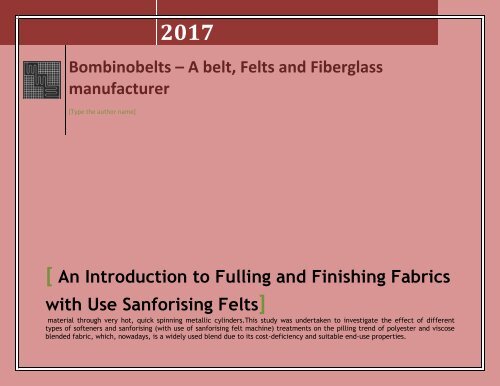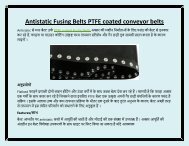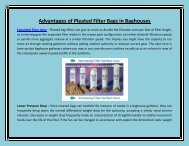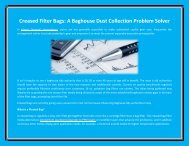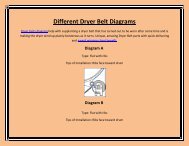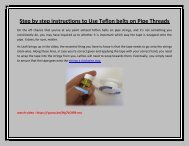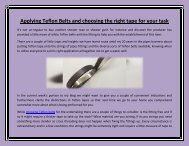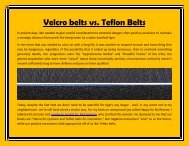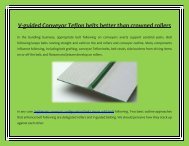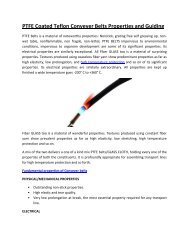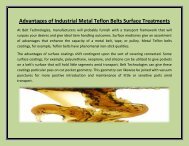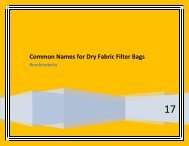An Introduction to Fulling and Finishing Fabrics with Use Sanforising Felts
This study was undertaken to investigate the effect of different types of softeners and sanforising (with use of sanforising felt machine) treatments on the pilling trend of polyester and viscose blended fabric, which, nowadays, is a widely used blend due to its cost-deficiency and suitable end-use properties. Sanforising felts - http://www.bombinobelts.com/product/sanforising-felts
This study was undertaken to investigate the effect of different types of softeners and sanforising (with use of sanforising felt machine) treatments on the pilling trend of polyester and viscose blended fabric, which, nowadays, is a widely used blend due to its cost-deficiency and suitable end-use properties. Sanforising felts - http://www.bombinobelts.com/product/sanforising-felts
Create successful ePaper yourself
Turn your PDF publications into a flip-book with our unique Google optimized e-Paper software.
2017<br />
Bombinobelts – A belt, <strong>Felts</strong> <strong>and</strong> Fiberglass<br />
manufacturer<br />
[Type the author name]<br />
[ <strong>An</strong> <strong>Introduction</strong> <strong>to</strong> <strong>Fulling</strong> <strong>and</strong> <strong>Finishing</strong> <strong>Fabrics</strong><br />
<strong>with</strong> <strong>Use</strong> <strong>Sanforising</strong> <strong>Felts</strong>]<br />
material through very hot, quick spinning metallic cylinders.This study was undertaken <strong>to</strong> investigate the effect of different<br />
types of softeners <strong>and</strong> sanforising (<strong>with</strong> use of sanforising felt machine) treatments on the pilling trend of polyester <strong>and</strong> viscose<br />
blended fabric, which, nowadays, is a widely used blend due <strong>to</strong> its cost-deficiency <strong>and</strong> suitable end-use properties.
Just about all seasoned weavers <strong>and</strong> knitters are knowledgeable about the<br />
process of fulling <strong>and</strong> finishing a newly fashioned h<strong>and</strong> weaved fabric.<br />
However, if you are new <strong>to</strong> the field of creating your own fabrics <strong>with</strong> natural<br />
fibers, you must be aware that once you might have come up <strong>with</strong> the<br />
garment, it is still not usable or wearable. It should first be put through a<br />
process called 'fulling'.
<strong>Fulling</strong> brings weight <strong>and</strong> density <strong>to</strong> a fabric <strong>to</strong> allow for dimension <strong>and</strong><br />
steadiness. It is a process which opens the fabric <strong>and</strong> transforms the palm<br />
woven threads in<strong>to</strong> your desired fabric. Depending on the sort of fibers you<br />
utilize, this process is not extremely difficult, but it is finicky so follow these<br />
guidelines if you are fulling for the first time. It is important <strong>to</strong> notice, before<br />
fulling any woven fibers all place skips <strong>and</strong> broken posts must be fixed. Not<br />
really this process will obviously have an effect on the structure <strong>and</strong> honesty of<br />
the material, leaving you <strong>to</strong> ask yourself why you started the task in the first<br />
place.<br />
<strong>Fulling</strong> involves five very important variables, heated drinking water, agitation,<br />
soap, fiber type <strong>and</strong> sett. Each distinction can be tweaked <strong>to</strong> work for your<br />
specific fabric. The hotter the water, the quicker the fabric will full. A lot<br />
more agitation <strong>and</strong> soap the quicker the fulling process. It is imperative <strong>to</strong><br />
keep watch over your fabric although it is in the process of fulling, mere<br />
seconds count. Underst<strong>and</strong>ing your fabric's fibers as well as the set, an open up<br />
sett fabric will full quicker than the usual closer set in place.<br />
Natural fabric fulling :-
Healthy fibers such as wools <strong>and</strong> cot<strong>to</strong>ns have natural oils <strong>and</strong> lanolin in the<br />
fiber. To full these natural fibers a combo of heat <strong>and</strong> frustration is needed.<br />
This process opens up every individual dietary fiber <strong>and</strong> interlocks them jointly.<br />
When these individual strings no longer move exclusively but fuse <strong>to</strong>gether, you<br />
have a fabric.<br />
Normal fabric finishes:-<br />
The basic finishing process for materials <strong>and</strong> knits allows the fabric <strong>to</strong> gain<br />
many valuable characteristics. Durability, normal water repellence <strong>and</strong><br />
resistance <strong>to</strong> shrinking, wrinkling, mildew, <strong>and</strong> fire being the most frequent<br />
characteristics. Natural fabrics require a resin finish treatment in order <strong>to</strong><br />
acquire the same easy care properties as synthetics.<br />
Finishes might also refer <strong>to</strong> the much wider concept, the dye color, bleaching,<br />
printing <strong>and</strong> the piping <strong>and</strong> hem.<br />
Types of finishes:-
The type of finish used on fabric will directly affect the style <strong>and</strong> feel of<br />
textiles. There are many finishes for natural fabrics, the following are the most<br />
popular closes found.<br />
<strong>Sanforising</strong> or Preshrinking- This is certainly achieved by nourishing the fabric<br />
between a roller <strong>and</strong> a silicone blanket. The rubber gaze the weft fibers which<br />
lead <strong>to</strong> shrinkage.<br />
<strong>Sanforising</strong> allows protecting against the organic cot<strong>to</strong>n from shrinking when<br />
rinsed. It is carried away by compressing the natural cot<strong>to</strong>n <strong>to</strong> reduce its<br />
diminishing capacity.<br />
Peach finish- A peach finish produces a velvety surface <strong>to</strong> the material. This<br />
kind of is created by working the information between abrasive rollers which<br />
lift <strong>and</strong> become softer the material <strong>to</strong> create the velvety feel.<br />
Calendering:-<br />
This kind of process creates a soft, shiny surface <strong>to</strong> the information. It is<br />
created by running the material through very hot, quick spinning metallic<br />
cylinders.
This study was undertaken <strong>to</strong> investigate the effect of different types of<br />
softeners <strong>and</strong> sanforising (<strong>with</strong> use of sanforising felt machine) treatments on<br />
the pilling trend of polyester <strong>and</strong> viscose blended fabric, which, nowadays, is a<br />
widely used blend due <strong>to</strong> its cost-deficiency <strong>and</strong> suitable end-use properties.<br />
Treatment is one of the most frequent types of finish applied <strong>to</strong> the fabrics.<br />
The technical literature of the softeners provided by way of manufacturers<br />
usually does not contain information on the effect of the softener's chemistry<br />
on the material pilling performance. This is hoped that the results of the study<br />
will help the practical finishers in better number of appropriate softener<br />
chemistry, particularly in cases when the pilling performance of the textile<br />
features critical importance.
With this info you have the basics <strong>to</strong> underst<strong>and</strong>ing the process of fulling <strong>and</strong><br />
finishing your recently created fabric. With this basic knowledge you will be<br />
able <strong>to</strong> comprehend your fiber or fabric instruc<strong>to</strong>r's vocabulary, as well as<br />
prepare you for any question you could be asked. Continue learning <strong>and</strong><br />
continue growing.


